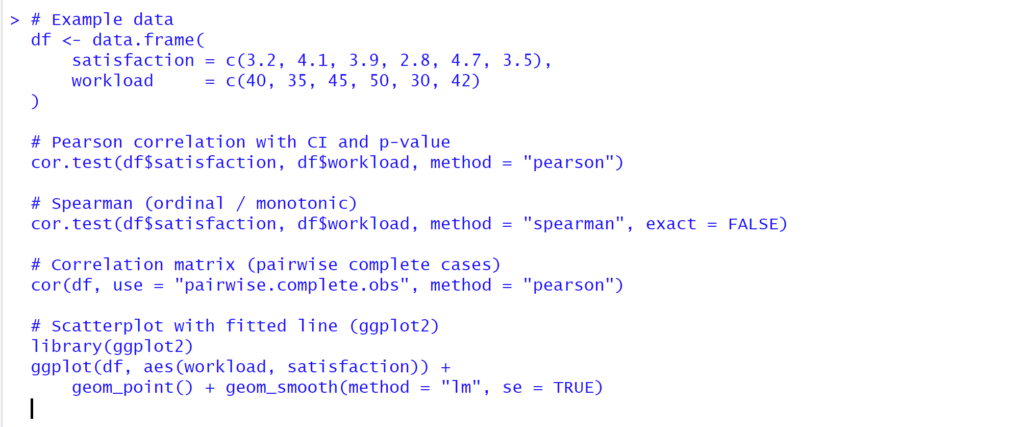Correlation measures the strength and direction of a relationship between two variables. The coefficient ranges from –1 to +1:
- +1 = perfect positive (as X increases, Y increases),
- –1 = perfect negative (as X increases, Y decreases),
- 0 = no linear/monotonic relationship.
Correlation describes association, not causation.
When to apply correlation
Use correlation when your research question is “Are X and Y related?” and your data meet the conditions for one of the tests below.
Pick the right flavour
- Pearson’s r — two continuous variables, linear relationship, roughly normally distributed (no big outliers), homoscedastic.
- Spearman’s ρ — variables are ordinal or you expect a monotonic (not necessarily linear) pattern; robust to outliers.
- Kendall’s τ — like Spearman but more conservative; good for small samples or many ties.
- Partial correlation — you want the X–Y link controlling for one or more other variables (e.g., age).
Before you run it
- Inspect scatterplots for linearity and outliers.
- Check measurement scales (don’t throw categorical variables into Pearson’s r).
- Decide how to handle missing data (pairwise vs listwise).
How to run correlation
SPSS
Bivariate correlation (Pearson/Spearman/Kendall)
- Analyze → Correlate → Bivariate…
- Move your variables to Variables.
- Choose Pearson, Spearman, or Kendall’s tau-b; tick Two-tailed and Flag significant if needed.
- Click Options… for descriptive stats / missing-data handling; Plots… for a scatterplot.
- OK to run.
Partial correlation
- Analyze → Correlate → Partial…
- Put your main variables in Variables and covariates in Controlling for.
- Choose Two-tailed; run.
jamovi
- Exploration → Correlation Matrix (in some versions: Analyses → Exploration → Correlation Matrix).
- Add variables to the box.
- Under Correlation coefficients, select Pearson or Spearman; add Confidence intervals, p-values, scatterplots as needed.
- For partials, use Regression → Linear Regression and add covariates (or install a partial-correlation module if available).
JASP
- Regression → Correlation Matrix (or Descriptives → check Correlation plots).
- Add variables; choose Pearson, Spearman, or Kendall.
- Tick CI, pairwise deletion, and plots if desired.
- For partial correlation, use Regression → Partial Correlation (if available) or run a linear model including covariates.
R (base & tidy)

How to interpret the output
- Coefficient (r, ρ, or τ)
- Sign gives direction (positive/negative).
- Magnitude gives strength (closer to |1| = stronger).
- Rules of thumb (context matters!): ~.10 small, ~.30 medium, ~.50 large.
- p-value
- Tests H₀: true correlation = 0. Report but don’t rely on p alone.
- Confidence interval
- A 95% CI for r shows plausible values for the population correlation.
- r² (coefficient of determination)
- Proportion of variance in Y associated with X (e.g., r = .40 ⇒ r² = .16 = 16%).
- Visual check
- Scatterplots reveal nonlinearity and outliers that can distort r.
Reporting examples (APA-style)
- Pearson: “There was a moderate negative correlation between workload and satisfaction, r(98) = –.43, 95% CI [–.57, –.26], p < .001.”
- Spearman: “Workload and satisfaction were negatively associated, ρ = –.41, p < .001.”
- Partial: “Controlling for age, workload and satisfaction remained correlated, partial r = –.36, p = .002.”
Common pitfalls & remedies
- Outliers dominate r → inspect & justify handling (winsorize, robust methods, or Spearman/Kendall).
- Nonlinearity → consider transformations or fit regression with polynomials/splines.
- Multiple tests → control false discovery (e.g., Holm/Benjamini–Hochberg).
- Likert items treated as interval → use Spearman or build a scale (e.g., average of items with good reliability) before Pearson.
- Causal claims → correlation ≠ causation; use longitudinal/experimental designs for causal inference.
Quick decision guide
- Two continuous, roughly normal, linear? → Pearson r
- Ordinal or outliers / monotonic? → Spearman ρ (or Kendall τ if many ties/small n)
- Need to adjust for covariates? → Partial correlation (or regression)
Correlation is a powerful first look at relationships. Choose the appropriate type (Pearson/Spearman/Kendall), run it with your preferred tool (SPSS, jamovi, JASP, or R), and interpret beyond the p-value—coefficient, CI, r², and plots—always remembering it reveals association, not causation.

